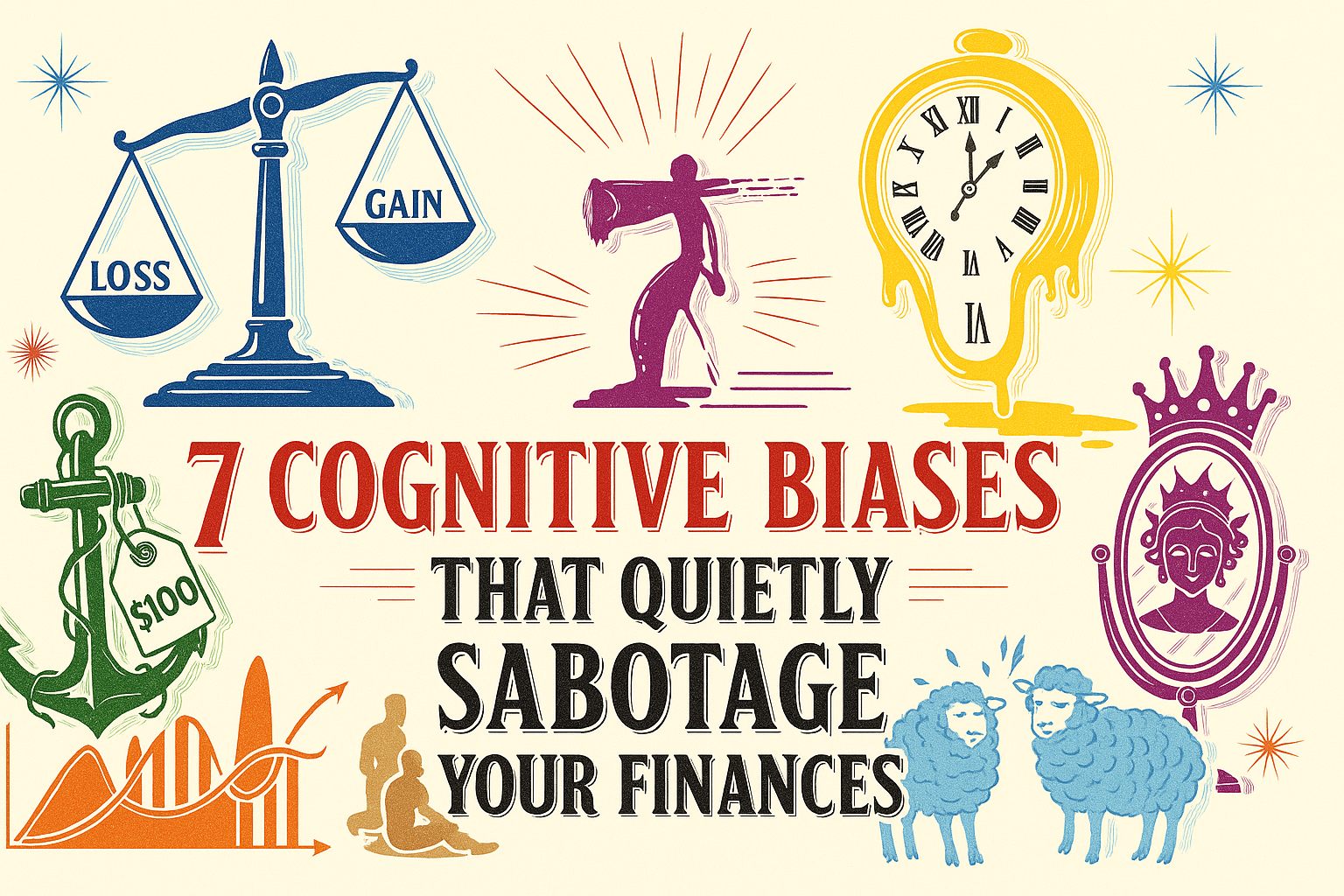7 Cognitive Biases That Quietly Sabotage Your Financial Life

Estimates suggest the average adult makes about 35,000 decisions every day. If we had to consciously think through each one, we’d be paralyzed. So instead, we rely on habits and shortcuts — what psychologists call heuristics — to lighten the mental load and keep life moving.
Most of the time, these shortcuts serve us well. But sometimes, they quietly lead us astray. That’s when they become cognitive biases — predictable patterns of thinking that can lead to poor decisions.
This topic fascinates me in general, but especially where it intersects with personal finance. So today, I want to break down 7 Cognitive Biases That Quietly Sabotage Your Financial Life — and what you can do about them.
1. Loss Aversion
People feel the pain of losses much more intensely than the pleasure of equivalent gains.
It makes sense when you think about our evolutionary wiring. For our ancestors, negative outcomes — like losing food or encountering danger — could be life-threatening. So our brains evolved to treat losses as a bigger deal than gains. This kept us alive, but it also causes us to make big money mistakes.
Let me give you a personal example.
A few months before I started my first job out of college, I got an unexpected email from my employer saying they were bumping up our base pay by $15,000. Amazing news.
Later that same day, I went to Chipotle and discovered my usual order had gone up by about a dollar. And honestly? I got kind of bummed out about it.
It wasn’t until hours later that I realized how ridiculous that reaction was. Objectively, I had just made a significant financial gain — and barely felt it. Meanwhile, a $1 increase triggered a real emotional response.
This is loss aversion in action.
In personal finance, this bias most often shows up by making people too timid to invest. Yes, investing carries risk. And yes, it’s uncomfortable to see your money temporarily go down. But I believe many people dramatically overweigh this risk — and as a result, ignore an even bigger risk: the slow erosion of your money’s value by inflation.
If you’re young and keeping all your extra cash in a bank account, you’re almost guaranteed to lose purchasing power over time.
By contrast, investing in a diversified, low-cost index fund might feel risky in the short term — but over the long term, it’s one of the most reliable ways to grow your wealth and improve your financial future.
What you can do about it:
- Reframe what “risk” actually means. The fear of losing money today might be causing you to miss out on wealth tomorrow. Inflation, stagnation, and opportunity cost are risks too — they’re just quieter.
- Stop checking your portfolio all the time. If you’re investing for the long term, daily or even monthly fluctuations don’t matter. Checking constantly just gives your brain more chances to freak out.
2. Present Bias (a.k.a. Hyperbolic Discounting)
You’ve probably heard of the famous marshmallow test.
Researchers at Stanford put a marshmallow in front of a child and told them: “You can eat this now, or wait 15 minutes and get two marshmallows.” Then they left the room and watched.
Everybody likes to think they’re a rational actor — weighing each decision carefully, thinking things through. But that’s not how we actually function.
Some kids waited. Most didn’t. But the big insight? Delaying gratification is hard — even when the reward is double.
We like to think we’re long-term thinkers. But in practice, most of us are just slightly taller versions of those kids. Given the choice between a smaller reward now or a bigger one later, our brains often scream: “Now!”
In personal finance, this bias shows up everywhere:
- Spending instead of saving
- Avoiding retirement contributions
- Putting off budgeting or tax planning
- Skipping the boring-but-important tasks that would make Future You way better off
It’s not that we don’t care about our future. It’s that our brains are wired to discount it. And over time, this quiet bias can cost you hundreds of thousands of dollars in missed compounding, inefficient choices, and financial stress.
What you can do about it:
- Make it ridiculously easy to start. Don’t aim for perfect. Promise yourself just 15 minutes a month to check in on your finances. Small steps build momentum.
- Automate the boring stuff. If you know you’ll spend whatever lands in your checking account, set up automatic transfers to savings or investments before you can touch it.
- Use friction to your advantage. Make it harder to access your savings. Add a 48-hour rule for big purchases. Trick your present self into protecting your future self.
3. Anchoring
Anchoring is when we latch onto a particular data point — and then struggle to let it go, even when it’s no longer relevant.
It happens constantly in personal finance. One of the most common examples I see with our members is this:
They own a single stock that once traded at $220. Today it’s at $130. They’re massively overexposed — maybe 50%, 70%, even 90% of their portfolio is tied up in this one company. They know it’s risky. They know it’s not ideal.
But they refuse to sell even a portion.
Why? “I’m just waiting for it to get back to $220.”
That $220 price becomes an emotional anchor. It creates the illusion that anything below that number is an unimaginably bad idea — even when it makes far more sense to diversify. They’re stuck chasing a high-water mark that may never return.
You see the same thing with housing. Someone looked at a house in 2021 that cost $750K. Now the same house is $950K. Even though their income has gone up and rates have stabilized, they refuse to buy — because they're anchored to the idea that homes should cost $750K, and therefore a crash must be coming.
But the market doesn’t care what it used to cost. And neither should your decisions today.
Anchoring keeps people stuck — waiting for old numbers to come back, even when the new reality demands a different approach. It’s like driving forward while staring in the rearview mirror.
What you can do about it:
If you already own something:
- Ask yourself: “If I didn’t already own this stock, would I go out today and buy it — in this amount?”
- If the answer is no, your anchor is showing. You’re making decisions based on the past, not what’s best for your portfolio now.
If you’re waiting to buy something:
- Humble yourself. Recognize that you're trying to time the market — and consistently outsmarting the collective wisdom of millions of buyers and sellers is incredibly hard. Just because a home, stock, or asset used to be cheaper doesn’t mean it should be again.
4. Overconfidence Bias
Overconfidence bias is when we overestimate our knowledge, instincts, or ability to predict the future. In short: we think we’re better than we are.
In investing, it doesn’t take much to fall into this trap.
I’ve seen it plenty. Someone makes a lucky stock pick — maybe based on a hunch or a hot tip — and it crushes the index over a few months. Suddenly, they think they’ve got an edge. They forget the other picks that flopped and how little research went into the win.
I’ve been there. In March 2020, during the COVID lockdowns, I jumped on Robinhood and made a few gut bets on high-risk tech stocks. I timed the bottom perfectly. Triple-digit gains rolled in, and I felt like a genius.
So I doubled down in 2021 — just before many of those same names started crashing. Look at a stock price chart of Block (NYSE: SQ) and you’ll get the idea.
I’m actually glad I learned that lesson early. I realized I’m not the next Warren Buffett — and that a little early success can quickly become dangerous overconfidence.
The data backs it up: even full-time professional investors with teams and tools rarely beat the market long-term. So when I see someone “get hot” and believe they’ve cracked the code, I get nervous. Because I’ve seen how that movie ends.
What you can do about it:
- Set up a small “fun money” portfolio. If you want to make bets, that’s totally fine. Just keep the amount small, and use money you’re genuinely okay losing. Think of it like a sandbox, not your retirement plan.
- Write down your thesis for your fun money portfolio. Why are you making these bets? What do you expect to happen, and by when? Then, check back in 5–10 years. Not 5–10 weeks. See if you beat the boring index — and whether your reasoning held up.
- Embrace how hard this really is. Most people don’t outperform passive investing. And that’s okay. I’m incredibly grateful I learned that lesson early — before I made bigger, more expensive mistakes.
5. Recency Bias
Recency bias is when we believe that whatever has been happening lately will keep happening.
When markets are surging, people forget that downturns even exist. They get overconfident, take on more risk, and assume the good times will roll on forever.
Then the opposite happens. Volatility hits, and suddenly that same person wants to pull everything out. They abandon their investment plan, panic sell, and tell themselves they’ll “get back in when things feel more stable.” Of course, by the time it feels stable again, the market has usually already rebounded — and they’ve locked in losses.
This is recency bias. It distorts our sense of risk and tricks us into reacting to short-term noise instead of sticking with long-term strategy.
I see it all the time. People who built thoughtful investment plans suddenly throw them out the window because the market has been rough for a few weeks. Or because headlines feel scary. Or because their portfolio dropped and they just want the pain to stop.
But emotional investing is expensive. And recency bias is often the culprit.
What you can do about it:
- Create an investment plan — and commit to sticking with it. Know in advance that things will get volatile. That’s not a bug; it’s part of the process. Pre-commit to staying the course.
- Automate your investments and stop checking every day. Don’t give yourself 100 chances a year to panic. Make good decisions once, automate them, and move on with your life.
- Make decisions based on you, not the news. Your age, goals, and risk tolerance matter far more than what the S&P did last week.
6. Status Quo Bias
Status quo bias is our tendency to prefer things to stay the same — even when change would clearly benefit us.
It’s rooted in a simple idea: we’re more afraid of the devil we don’t know than the devil we do.
And yet, ironically, research shows that people tend to regret the things they don’t do far more than the things they try and get wrong.
Why? Because change takes cognitive effort. It forces us to feel uncertain, risk making mistakes, or admit we’ve been doing something less-than-ideal. It’s much easier to stick with the default — even when the default is actively costing us.
This bias shows up all over the place in personal finance:
- Leaving your money in a bank account that pays 0.01% interest
- Avoiding a refinance that would save you thousands
- Staying in a job that underpays or burns you out — just because the process of switching feels like too much
But here’s the thing: doing nothing is still a choice. And unfortunately, the cost of inaction tends to compound over time.
What you can do about it:
- Make the default action progress. Set a recurring calendar reminder — monthly, quarterly, whatever you’ll commit to — to review your money systems. You don’t need to overhaul everything, just keep nudging forward.
- Start small. Open a high-yield savings account. Revisit your credit card interest rate. Schedule one informational interview. One small change is all it takes to break the inertia.
- Remember: change doesn’t have to be perfect. You don’t need to get everything right. But refusing to change at all? That’s almost guaranteed to hold you back.
7. Herd Mentality
Humans are social creatures. We naturally look to others in our circle — friends, coworkers, family — to guide our behavior, especially when we’re unsure or overwhelmed.
But when it comes to money, this instinct can quietly steer us off course.
I’ve seen people make massive financial decisions based on loose social signals. Someone buys a house because “all my friends are buying right now,” without seriously considering whether it’s the right move for their budget or their life goals. Someone else upgrades their car because everyone at work drives a luxury brand — even though it adds thousands in monthly costs they can’t comfortably afford.
Even investing gets distorted. People jump into particular stocks or NFTs, simply because their group chat is doing it. They mistake what’s popular for what’s smart.
The problem? The herd doesn’t know your full financial picture. And honestly, the herd is often wrong.
What you can do about it:
- Understand that most people don’t have it figured out. Many are winging it — and making emotional or biased decisions themselves.
- Don’t be afraid to be different. Driving the older car, renting longer, skipping the hot stock — these moves can feel isolating in the moment but wildly smart in the long run.
- Do your own homework. Before making any big financial decision — especially around homes, cars, or investments — take time to understand your numbers, your risks, and your goals.
These cognitive biases aren’t flaws — they’re features of how human brains evolved to survive in a very different world than the one we live in today.
The key isn’t to eliminate them — it’s to recognize them. To pause when emotion kicks in, to build systems that protect you from your impulses, and to consistently prioritize your long-term goals over your short-term feelings.
Mastering money is less about knowing what to do — and more about understanding how your brain gets in the way of doing it.
Disclosure: This article is provided for informational and educational purposes only and should not be construed as investment, tax, or legal advice. The views expressed are those of the author and do not necessarily reflect the official position of Fifr. All investments carry risk, and past performance is no guarantee of future results. You should consult with a qualified financial professional before making any investment decisions. Fifr is an SEC-registered investment adviser; registration does not imply a certain level of skill or training. For additional information, please refer to our Form ADV, available at https://adviserinfo.sec.gov/firm/summary/328620.




